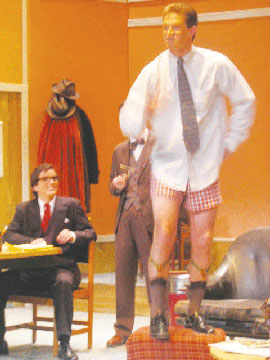At 8pm on Friday night a well-groomed, delightfully attired, cast of seven men and two women graced an audience of 30 people with their second performance of Neil Simon’s comedy Laughter on the 23rd Floor. So was it worth the two hours and the $8-10?
If you want to kill a couple of hours and few bucks, then yes. To state it bluntly, both the acting and the play were mediocre at best. Despite the obvious mediocrity, the script forced us to face issues relevant in today’s politically fired arena. Yes, though at times audience members “rested their eyes,” the play did prove to be an interesting rendering of issues that seem all too familiar in today’s world. Set in the McCarthy era of the 1950s, the play touched upon issues like communism (which was both misrepresented and misunderstood at the time), censorship, and mistrust in leadership. With such issues as the war in Iraq, the re-election of Bush into and the current fear of Muslims in this country, one could barely escape the parallels between modern day politics and the politics of the 1950s. The play showed spectators that, though the times are changing, some issues are reoccurring.
To give credit where credit is due, some actors performed better than others. Attractive and animated Matt Flynn, who played the lead role of Max Prince, gave a fantastic performance. He truly brought to life the character of Max Prince: his flailing gestures and his excellent timing were two examples of his exemplary performance. Likewise, Rocky Graziano, who played the role of Ira, added excitement to the stage with his flamboyance and his crazy, electric, performance. Rocky Graziano also did a wonderful job bickering with Andrew Boyle (Brian), whose exceptionally bad hair transplant took center stage and was quite funny. But for the rest of the performers, poor execution of comedic lines gave the play a contrived feel.
Two main female character roles, Jenn Shea and Lyn Ben-Simon cast as Carol and Helen, were particularly bad. The bad acting, however, was not entirely there fault so much as it was the script’s-the 1950s had not come to fully understand women as the independent, liberated, and delightful creatures that we view them as today, and this misrepresentation penetrated the two women’s performances. Lyn Ben-Simon for example, played the stereotypical role of the uneducated, and seemingly stupid, secretary. Though the secretary later went to law school, her character fully represented the idea of being female in the 1950s. Jenn Shea’s performance as Carol was not much better, as she did not have any truly funny lines, despite her more powerful role as a comedy writer. Jenn Shea’s mere presence softened the stage as she fell victim to the role of the essential barefoot and pregnant woman. Though their roles were disappointing, they clearly represented a universal misinterpretation of women common to that time period.





















































